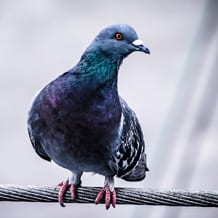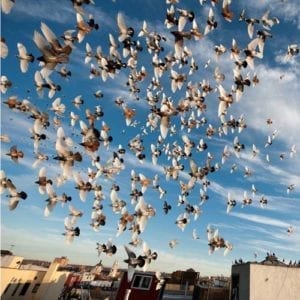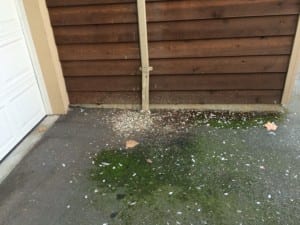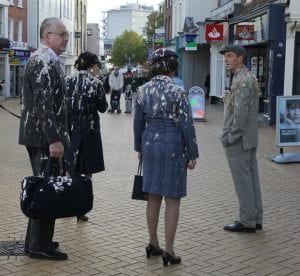
by johnnymarin | Feb 1, 2019 | Bird Deterrent Products
 When a scruffy pigeon first flew onto the Germscheid family ranch near Entwistle, Greg didn’t know what to think.
When a scruffy pigeon first flew onto the Germscheid family ranch near Entwistle, Greg didn’t know what to think.
“He looked so terrible when he came here,” the rancher recalled of Sept. 19, when he first noticed the bird.
But three weeks ago, Greg extended a hand to the pigeon in friendship.
“I actually picked him up in both hands and he didn’t struggle,” Greg recalled.
It turns out—as pigeons go—the nicknamed ‘Pidge’ is somewhat remarkable.
“He just seems to have taken on a personality, you know?”
Now, Pidge comes when called, perches on Greg’s shoulder and goes for sleigh rides.
The two are nearly inseparable.
“Every morning, Greg gets up and says, ‘I better go see my Pidge, see how he’s doing,’” Maureen, Greg’s wife, told CTV News.
The Germscheids don’t know what makes Pidge so friendly or smart. They’ve wondered if pigeon sees them as parents, or if he came from a breeder.
Or—they’ve considered—Pidge is just an exceptional animal.
“There’s a little magic in everything, you know?” Greg asked.
The couple doesn’t cage Pidge, so he could leave as suddenly as he showed up. However, no matter what he chooses, Pidge will have friends among the Germscheids.
About Pigeon Patrol:
Pigeon Patrol Products & Services is the leading manufacturer and distributor of bird deterrent (control) products in Canada. Pigeon Patrol products have solved pest bird problems in industrial, commercial, and residential settings since 2000, by using safe and humane bird deterrents with only bird and animal friendly solutions. At Pigeon Patrol, we manufacture and offer a variety of bird deterrents, ranging from Ultra-flex Bird Spikes with UV protection, Bird Netting, 4-S Gel and the best Ultrasonic and audible sound devices on the market today.
Voted Best Canadian wholesaler for Bird Deterrent products four years in a row.
Contact Info: 1- 877– 4– NO-BIRD (www.pigeonpatrol.ca)

by johnnymarin | Jan 31, 2019 | Pigeons in the News
 On Saturday, two patients died after contracting a fungal infection linked to pigeon droppings.
On Saturday, two patients died after contracting a fungal infection linked to pigeon droppings.
While one death was reportedly not a result of contracting Cryptococcus, health chiefs are now looking into the passing of another patient, believed to be a child, as the factors leading to the death are currently unclear.
It was reported on Sunday that the Scottish Government had been aware of the issue since December.
However, a freedom of information request which has been shared with the Evening Times shows complaints relating to pigeons in the ceiling of the super hospital were made as early as January 2017.
Throughout 2017 a total of 12 issues were flagged up relating to the birds in just one department of the building.
In August and September 2017 the problem of pigeon dropping being in close-proximity to patients was shared with environmental staff at NHSGreater Glasgow and Clyde (NHSGGC), with one reporting pigeons roosting and fouling at an ambulance entrance.
NHSGGC declined to comment on the series of 2017 complaints relating to the birds. A spokesman for the health board said: “Like many very large buildings the hospital can at times attract birds.
“We have a number of control measures in place to prevent them gathering and are exploring further options to add to the existing measures.”
According to the freedom of information document, written in 2018, pigeon excrement is “periodically brushed away” and areas are power washed as required.
Netting and spikes were also installed at the hospital to prevent pigeons roosting.
However, this is limited in periods when temperatures are low to avoid ice forming.
The document adds: “NHSGGC endeavours always to provide the best experience possible for patients, their relatives, our staff, and other members of the public, in premises which are pleasant, and conducive to good health and recovery.
“The situation with the pigeons is continually monitored by NHSGGC and we are proactive in our efforts to reduce the problem.
“However, we have sought comments from our consultant in public health with special responsibility for environmental concerns who advised us that, in general, the risk for health posed by exposure to these pests is considered to be relatively minor.
“We are aware that this particular issue concerns a hospital and a population of potentially vulnerable patients rather than a residential or commercial premises, but an infestation of this kind would normally be considered as an environmental nuisance rather than a major risk for human health.”
In a statement following the deaths an NHSGGC spokesman said: “Our thoughts are with the families at this distressing time.
“These two cases of infection were identified in December and an Incident Management Team was formed. A likely source was identified and dealt with immediately.
“We are unable to comment further on the two cases due to patient confidentiality.”
On Friday some patients with compromised immunity, both children and adults, were transferred to other areas of the hospital away from the source of the infection.
The health board have since confirmed that the affected area is “non-public” and the droppings had been removed.
Alongside this, air quality tests have been carried, with filters being installed to monitor this and are said to be working effectively. No other cases have yet been detected.
The infection is caused by inhaling spores of the fungus Cryptococcus, carried in the air, found in the bird’s droppings. Most infections are mild and produce either no symptoms or a minor influenza – like illness.
However the disease can cause meningitis, high fever, blood abnormalities, pneumonia and even death.
Those experiencing issues with their immune system are the most susceptible to complications, with the infection remaining rare amongst healthy individuals.
About Pigeon Patrol:
Pigeon Patrol Products & Services is the leading manufacturer and distributor of bird deterrent (control) products in Canada. Pigeon Patrol products have solved pest bird problems in industrial, commercial, and residential settings since 2000, by using safe and humane bird deterrents with only bird and animal friendly solutions. At Pigeon Patrol, we manufacture and offer a variety of bird deterrents, ranging from Ultra-flex Bird Spikes with UV protection, Bird Netting, 4-S Gel and the best Ultrasonic and audible sound devices on the market today.
Voted Best Canadian wholesaler for Bird Deterrent products four years in a row.
Contact Info: 1- 877– 4– NO-BIRD (www.pigeonpatrol.ca)

by johnnymarin | Jan 30, 2019 | Bird Deterrent Products
 A former health secretary has called for an inquiry into the deaths of two hospital patients who contracted a rare infection linked to pigeon droppings. Alex Neil said the cause of the deaths and the handling of the cases by Scotland’s biggest health had to be looked into. The Cryptococcus infections have been linked to the excrement of birds that got into a non-public area at the flagship Queen Elizabeth Hospital in Glasgow. NHS Greater Glasgow and Clyde (NHSGCC) has launched a probe into the death of one patient, with the cause still to be determined. The health board said the second patient affected – who was elderly – died of an unrelated matter. The Scottish government confirmed the infection was reported in December. Mr Neil told BBC Scotland: “I think there has to be an outside inquiry by experts to find why this happened in the first place, secondly how it has been handled by the health board and, thirdly, what precautions need to be taken for the future.” The SNP MSP for Airdrie and Shotts, who was health secretary between 2012 and 2014, questioned why it took three weeks for the news to be made public. He added: “There are confusing messages coming out of the health board so they need to clarify the situation and do so as a matter of urgency.” “There are confusing messages coming out of the health board so they need to clarify the situation and do so as a matter of urgency” Alex Neil A non-public room, thought to contain machinery, has been identified as a likely source. Measures have been taken to keep pigeons out of the area while portable units that filter the air continuously have been installed. A Scottish government spokesman: “Our primary concern, and that of the Health Board, remains the safety and wellbeing of the patients and their families at the hospital. “There is an on-going review of two isolated cases of an unusual fungal infection within the Queen Elizabeth University Hospital site, which were detected in December 2018.” A spokesman for NHS Greater Glasgow and Clyde health board said an investigation remains ongoing. “These two cases of infection were identified in December and an incident management team was formed. “A likely source was identified and dealt with immediately. “The small number of paediatric and adult patients who are vulnerable to this infection are receiving medication to prevent potential infection and this has proved effective. “Air sampling was carried out and HEPA filters were brought in on 10 January to specific areas before conclusive results were available. “Results identifying the organism were obtained on 16 January. “Early indications suggest the filters are having a positive effect. “The organism is harmless to the vast majority of people and rarely causes disease in humans. “We are unable to comment further on the two cases due to patient confidentiality.”
A former health secretary has called for an inquiry into the deaths of two hospital patients who contracted a rare infection linked to pigeon droppings. Alex Neil said the cause of the deaths and the handling of the cases by Scotland’s biggest health had to be looked into. The Cryptococcus infections have been linked to the excrement of birds that got into a non-public area at the flagship Queen Elizabeth Hospital in Glasgow. NHS Greater Glasgow and Clyde (NHSGCC) has launched a probe into the death of one patient, with the cause still to be determined. The health board said the second patient affected – who was elderly – died of an unrelated matter. The Scottish government confirmed the infection was reported in December. Mr Neil told BBC Scotland: “I think there has to be an outside inquiry by experts to find why this happened in the first place, secondly how it has been handled by the health board and, thirdly, what precautions need to be taken for the future.” The SNP MSP for Airdrie and Shotts, who was health secretary between 2012 and 2014, questioned why it took three weeks for the news to be made public. He added: “There are confusing messages coming out of the health board so they need to clarify the situation and do so as a matter of urgency.” “There are confusing messages coming out of the health board so they need to clarify the situation and do so as a matter of urgency” Alex Neil A non-public room, thought to contain machinery, has been identified as a likely source. Measures have been taken to keep pigeons out of the area while portable units that filter the air continuously have been installed. A Scottish government spokesman: “Our primary concern, and that of the Health Board, remains the safety and wellbeing of the patients and their families at the hospital. “There is an on-going review of two isolated cases of an unusual fungal infection within the Queen Elizabeth University Hospital site, which were detected in December 2018.” A spokesman for NHS Greater Glasgow and Clyde health board said an investigation remains ongoing. “These two cases of infection were identified in December and an incident management team was formed. “A likely source was identified and dealt with immediately. “The small number of paediatric and adult patients who are vulnerable to this infection are receiving medication to prevent potential infection and this has proved effective. “Air sampling was carried out and HEPA filters were brought in on 10 January to specific areas before conclusive results were available. “Results identifying the organism were obtained on 16 January. “Early indications suggest the filters are having a positive effect. “The organism is harmless to the vast majority of people and rarely causes disease in humans. “We are unable to comment further on the two cases due to patient confidentiality.”
About Pigeon Patrol:
Pigeon Patrol Products & Services is the leading manufacturer and distributor of bird deterrent (control) products in Canada. Pigeon Patrol products have solved pest bird problems in industrial, commercial, and residential settings since 2000, by using safe and humane bird deterrents with only bird and animal friendly solutions. At Pigeon Patrol, we manufacture and offer a variety of bird deterrents, ranging from Ultra-flex Bird Spikes with UV protection, Bird Netting, 4-S Gel and the best Ultrasonic and audible sound devices on the market today.
Voted Best Canadian wholesaler for Bird Deterrent products four years in a row.
Contact Info: 1- 877– 4– NO-BIRD (www.pigeonpatrol.ca)

by johnnymarin | Jan 29, 2019 | Pigeon Patrol's Services
 In January, thousands of pigeon fanciers flock to the seaside resort of Blackpool where the fastest and most beautiful pigeons are cooed over by some of the most expert keepers in the game.
In January, thousands of pigeon fanciers flock to the seaside resort of Blackpool where the fastest and most beautiful pigeons are cooed over by some of the most expert keepers in the game.
The British Homing World Show of the Year is the UK’s biggest gathering of pigeon fanciers, attracting up to 15,000 people to the northwest coast of England.
“Whether you are a new member, curious about pigeons, or a veteran pigeon fancier, there is something for everyone at the show,” the event promises.
It is held in Blackpool’s historic Winter Gardens venue.
The Beatles, Queen and Oasis have played in the ballroom and every post-World War II British prime minister has spoken there during party conferences.
But on the third weekend in January, the ballroom is filled with more than 2,000 pigeons, divided into those bred for showing and for racing.
“The atmosphere is very good. It’s basically a reunion for pigeon fanciers. There are people from all over the country meeting up once a year,” said David Trippett, chairman of the show’s organising committee.
“It’s all good competition. Win or lose, people still have a smile on their face,” he told AFP.
– Year-round commitment –
The stereotypical portrayal of a pigeon fancier — working class and from the industrial cities of northern England — no longer rings true.
Queen Elizabeth II keeps pigeons, and the royal loft manager was at the show.
Trippett said it took a special kind of person to keep pigeons.
“It’s commitment. You have to have a commitment to pigeons to be a good pigeon racer,” he said.
“It’s a 365-days-a-year occupation. You can’t go off for a couple of days and leave them. They need cleaning out, feeding, training.
“It’s a lifestyle. You just do it and enjoy it. There’s no finer experience than seeing your pigeons coming home, pigeons that you have fed, bred and nurtured, coming back to your loft from a 500-mile race.
You think: ‘I did that’.”
The show dates back to 1972 and has been held in Blackpool since 1977. Profits go to charity.
Besides the ballroom, trade stalls sell every conceivable pigeon accessory, and birds themselves are up for sale.
– Pigeon v tech –
Trippett said the sport was struggling to compete in a world of video games and digital entertainment.
“It’s fighting with a technological age and it is declining because of that but we are coming up with new incentives to bring more people into the sport,” he said.
There’s a young fanciers programme and lofts are being installed in schools. They are particularly successful with children with special educational needs, said Trippett.
Technology is also creeping into the sport, with live streams of lofts.
Pigeon fancier John Bell won the supreme champion show pigeon title for the seventh time — and the fourth time in a row.
This year’s winner, who is unnamed, was a one-year-old chequer cock pigeon, who won a competition in Scotland to qualify for Blackpool.
“It’s a fantastic achievement. It’s the pinnacle. It’s like winning the lottery for everyone else,” Bell told AFP.
“You’ve got to keep them in the best condition you can; bug free, lice free. The preparation for next year starts now.
“On the judging day, you’re prepping them up to keep them spotless.
“We pride ourselves on this.”
About Pigeon Patrol:
Pigeon Patrol Products & Services is the leading manufacturer and distributor of bird deterrent (control) products in Canada. Pigeon Patrol products have solved pest bird problems in industrial, commercial, and residential settings since 2000, by using safe and humane bird deterrents with only bird and animal friendly solutions. At Pigeon Patrol, we manufacture and offer a variety of bird deterrents, ranging from Ultra-flex Bird Spikes with UV protection, Bird Netting, 4-S Gel and the best Ultrasonic and audible sound devices on the market today.
Voted Best Canadian wholesaler for Bird Deterrent products four years in a row.
Contact Info: 1- 877– 4– NO-BIRD (www.pigeonpatrol.ca)

by johnnymarin | Jan 28, 2019 | Pigeon Patrol's Services
 Two people died this month after contracting a fungal infection linked to pigeon droppings.
Two people died this month after contracting a fungal infection linked to pigeon droppings.
According to The Guardian, investigators believe the individuals contracted the disease at the Queen Elizabeth University Hospital in Glasgow, Scotland. The patients—a child and an elderly man—were being treated for Cryptococcus, an airborne fungus that’s typically linked to wild bird feces. NHS Greater Glasgow and Clyde, the board that runs the hospital, confirmed that the senior man died from unrelated the causes, while the factors contributing to the child’s death are still under investigation.
NHS officials announced the hospital has taken “control measures” to ensure other patients aren’t infected. Though Cryptococcus is considered harmless to the majority of humans, the hospital has installed portable air filters to prevent further infections. A small group of child and adult patients who may be vulnerable to the infection been given preventative medication. Officials also said the likely source was found in a non-public hospital room that has since been cleaned.
“[…] Most people who are exposed to it never get sick from it,” Teresa Inkster of NHSGGC told The Guardian. “We are continuing to monitor the air quality and these results are being analyzed. It remains our priority to ensure a safe environment for patients and staff.”
The hospital has not identified any other Cryptococcus cases since the control measures were implemented.
The NHS said it could not provide any more details about the aforementioned deaths due to patient confidentiality.
About Pigeon Patrol:
Pigeon Patrol Products & Services is the leading manufacturer and distributor of bird deterrent (control) products in Canada. Pigeon Patrol products have solved pest bird problems in industrial, commercial, and residential settings since 2000, by using safe and humane bird deterrents with only bird and animal friendly solutions. At Pigeon Patrol, we manufacture and offer a variety of bird deterrents, ranging from Ultra-flex Bird Spikes with UV protection, Bird Netting, 4-S Gel and the best Ultrasonic and audible sound devices on the market today.
Voted Best Canadian wholesaler for Bird Deterrent products four years in a row.
Contact Info: 1- 877– 4– NO-BIRD (www.pigeonpatrol.ca)

 When a scruffy pigeon first flew onto the Germscheid family ranch near Entwistle, Greg didn’t know what to think.
When a scruffy pigeon first flew onto the Germscheid family ranch near Entwistle, Greg didn’t know what to think.



